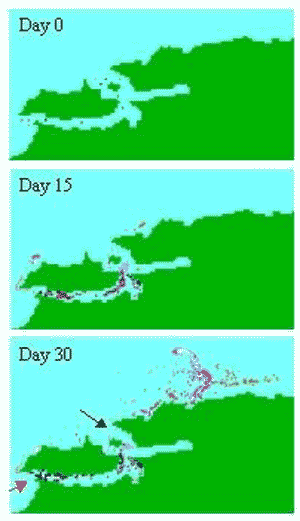| 2003 |

|
YEAR BOOK |
Bord Iascaigh Mhara
|
Coupled biological-physical modelling in fisheries and aquaculture
|

Transport of pelagic organisms is the result of the interplay of physical oceanographic processes (advection, diffusion, turbulence) and biological processes (behavioural response of the organism to the physical environment, population decay, development rate). Coupled bio-physical models provide predictive or simulated output of the combined effects of the physical and biological processes with respect to how the larval population disperses from its source.
Marcon Computations Ltd (Dr Michael Hartnett) and BIM have recently developed a model of the dispersal of scallop larvae in the Valentia Harbour and Dingle Bay areas. This model can be used to service the requirements of fisheries management and aquaculture development for this species in the area. A number of specific questions can be addressed such as:
|
1.�To what degree are scallop stocks in Dingle Bay and Valentia Harbour connected?
2. In what locations might larvae be successfully collected in large numbers for aquaculture? 3. Will enhancement of populations of scallop within Valentia lead to a self generating increase in recruitment? |
Figure 1 displays the output of a single run of the bio-physical model forced by south westerly wind conditions. Wind data for the area were sourced from the Valentia Meteorological Station. Particles are released into the system at a number of locations. These particles are given properties (size, density) that are similar to scallop larvae and are followed for a period of time representing the maximum longevity of the larvae at water temperatures prevalent in the Valentia area. Snapshots are presented of the distribution of the population of particles (larvae) at the start (Day 0), middle (Day 15) and end (Day 30) of the time period. A large proportion of the larval population is retained in Valentia Harbour. Transport in south westerly wind conditions occurs from the northern side of the harbour into Dingle Bay (Black arrow). There is little transport through the western entrance (Red arrow). There is some mixing of the separate (colour coded) larval inputs in Valentia Harbour, although in some areas larvae are largely retained in the area where they were sourced.
The output from this model indicates a largely efficient retention of scallop larvae within the Valentia area. Self recruitment should therefore be effective but is dependent on wind forcing. Specific locations for the collection of larvae for aquaculture can be pinpointed as there are identifiable transport routes and retention areas within the main Channel.
The interdisciplinary research represented by this project adds significant value to empirical biological data on distributions and ecology, and brings marine biological research into the realms of simulation, scenario testing, prediction and forecasting.
Contact: Dr Oliver Tully, Fisheries Development Division, BIM,
New Docks Road, Galway;
E-mail: [email protected]